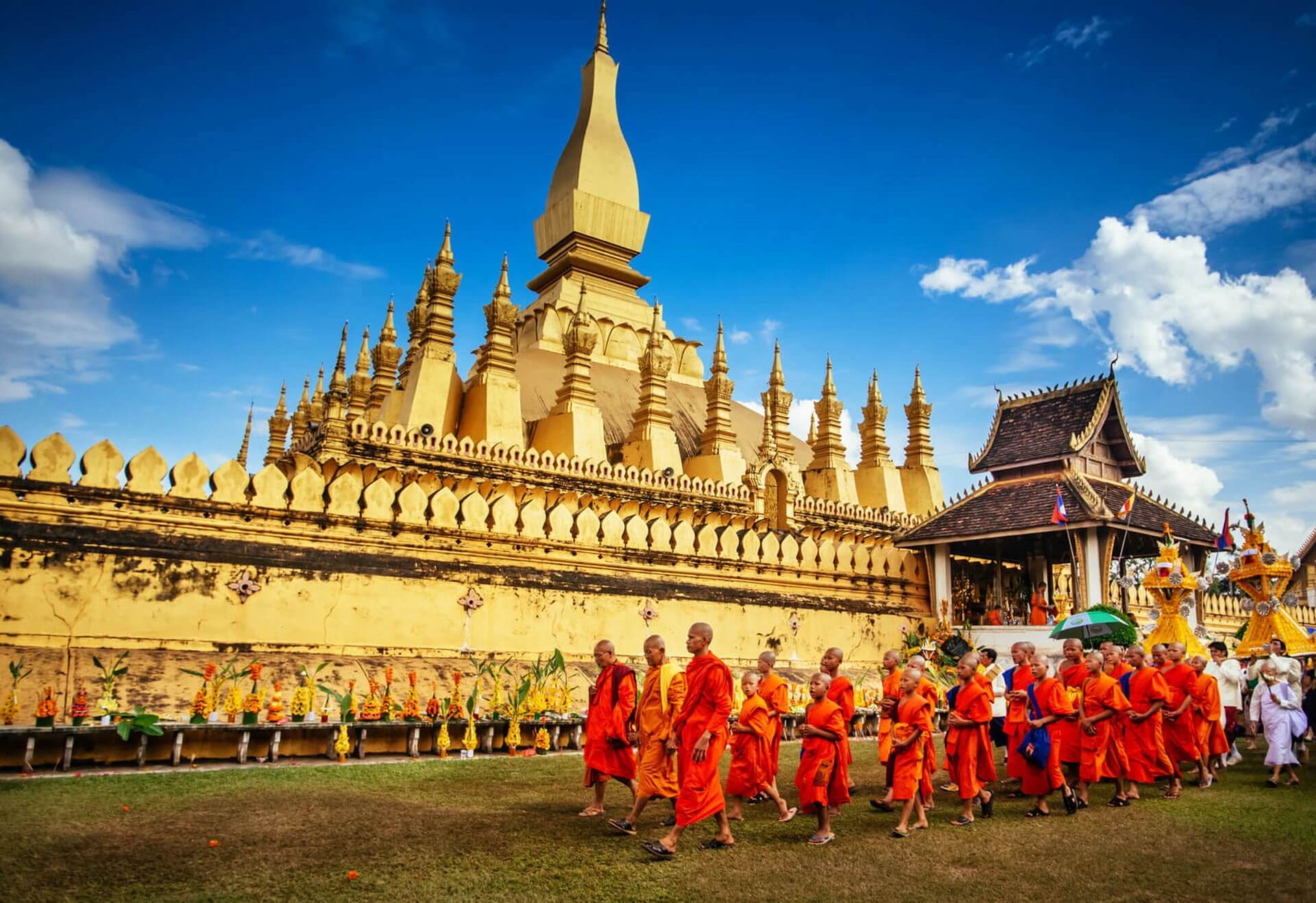Spiritual Travel in Laos: Temples and Traditions

Spiritual Travel in Laos: Temples and Traditions
Contents
Discover authentic spiritual experiences in Laos through ancient temples, Buddhist traditions, and sacred ceremonies in Luang Prabang and beyond.
Introduction
Nestled in the heart of Southeast Asia, Laos remains one of the region’s most authentic and spiritually enriching destinations. This landlocked nation, often overshadowed by its more touristy neighbors, offers travelers something increasingly rare in our modern world: genuine spiritual experiences rooted in centuries-old traditions.
Buddhism isn’t just a religion in Laos – it’s the very fabric of daily life. From the gentle sound of temple bells at dawn to the saffron-robed monks walking through ancient streets, spirituality permeates every aspect of Lao culture. The country’s 60% Buddhist population maintains traditions that have remained largely unchanged for generations, creating an atmosphere of profound peace and authenticity.

Travel in Laos offers more than beautiful landscapes – it’s a journey into timeless spiritual traditions. Unlike the commercialized spiritual tourism found elsewhere, Laos provides opportunities for genuine cultural immersion and personal reflection. Whether you’re seeking inner peace, cultural understanding, or simply a break from the chaos of modern life, Laos’ spiritual heritage offers transformative experiences that resonate long after you return home.
The Spiritual Essence of Laos
Theravāda Buddhism, the dominant religious tradition in Laos, forms the cornerstone of the nation’s spiritual identity. This ancient form of Buddhism, also known as the “Teaching of the Elders,” emphasizes meditation, mindfulness, and the pursuit of enlightenment through personal discipline and understanding.

In Lao society, monks hold a position of deep respect and spiritual authority. These dedicated practitioners, identifiable by their distinctive saffron robes, serve not only as religious leaders but as teachers, counselors, and guardians of cultural traditions. Their daily routines of meditation, study, and community service provide a living example of Buddhist principles in action.
The wat (temple) stands at the center of every Lao community, serving multiple roles beyond religious worship. These sacred spaces function as educational centers, community gathering places, and repositories of local history and art. The architectural beauty of these temples, with their sweeping roofs, intricate carvings, and golden stupas, reflects the profound devotion of the Lao people to their spiritual heritage.
Daily rituals punctuate life in Laos with meaning and mindfulness. The morning almsgiving ceremony, evening chanting, and regular meditation sessions create a rhythm of spiritual practice that visitors can observe and, with proper respect, participate in. Understanding Laos spirituality requires recognizing that Buddhism in Laos isn’t merely practiced—it’s lived.
For travelers, cultural respect and spiritual etiquette are essential. This means dressing modestly at temples, removing shoes before entering sacred spaces, and approaching religious ceremonies with quiet reverence. Understanding these practices enhances your spiritual journey while showing respect for the traditions that define Lao culture.
Must-Visit Spiritual Sites in Laos
Luang Prabang – The Heart of Spiritual Laos
Luang Prabang, the former royal capital and UNESCO World Heritage site, stands as the spiritual heart of Laos. This enchanting city, where the Mekong and Nam Khan rivers converge, offers the most concentrated collection of spiritual experiences in the country.
Wat Xieng Thong represents the pinnacle of Lao religious architecture. Built in 1560, this magnificent temple complex showcases the classical Lao style with its distinctive low-sweeping roofs and elaborate decorative elements. The temple’s golden facade and intricate mosaics tell stories of Buddhist cosmology and Lao royal history. The famous “Tree of Life” mosaic on the exterior wall is particularly stunning, depicting Buddhist paradise in brilliant colored glass.

The daily almsgiving ceremony (Tak Bat) provides visitors with perhaps the most authentic spiritual experience in Laos. Beginning before dawn, this ancient ritual sees hundreds of monks walking silently through the streets, collecting rice and other offerings from devout locals. Participating respectfully in this ceremony—by offering food to monks or simply observing quietly—connects travelers to a tradition that has remained unchanged for centuries.
Luang Prabang also offers opportunities for deeper spiritual engagement through meditation retreats and short temple stays. Several wats welcome visitors for meditation sessions, Buddhist teachings, and cultural exchanges. These experiences provide insight into monastic life and Buddhist philosophy while supporting local religious communities.
The city’s spiritual atmosphere extends beyond its temples. Traditional wooden houses, French colonial architecture, and the gentle pace of life create an environment conducive to reflection and mindfulness. Travel in Laos is incomplete without experiencing Luang Prabang’s sacred calm—a quality that transforms ordinary sightseeing into spiritual pilgrimage.
Vientiane – Ancient and Modern Faith
Laos’ capital city, Vientiane, offers a unique blend of ancient spiritual traditions and modern urban life. Despite its status as the country’s largest city, Vientiane maintains a relaxed atmosphere where spiritual practices continue to thrive alongside contemporary developments.

Pha That Luang, the golden stupa that serves as Laos’ national symbol, stands as the most important religious monument in the country. This magnificent structure, rebuilt in the 16th century on the site of an earlier Khmer temple, represents the essence of Lao Buddhism. The three-tiered stupa, covered in gold and rising 45 meters into the sky, symbolizes the stages of Buddhist enlightenment. Visiting during the annual That Luang Festival in November provides insight into the deep spiritual significance this monument holds for the Lao people.

Wat Si Saket, built in 1818, houses thousands of Buddha images in various sizes and styles. The temple’s unique architecture, influenced by Thai design, survived the Siamese invasion of 1827 and remains one of Vientiane’s oldest temples. The cloister surrounding the main hall contains over 2,000 ceramic and silver Buddha images, creating an overwhelming atmosphere of devotion and artistic beauty.
Vientiane demonstrates how spirituality adapts to modern life without losing its essence. Morning almsgiving ceremonies continue along busy streets, while evening meditation sessions provide city dwellers with spiritual respite. The city’s numerous temples serve active communities, proving that urbanization and spiritual practice can coexist harmoniously.
Pakse and the South – Hidden Spiritual Gems
Southern Laos, centered around Pakse, offers spiritual travelers access to some of the country’s most mysterious and ancient sacred sites. This region, less visited than the north, provides opportunities for deeper cultural immersion and spiritual discovery.

Wat Phou, a UNESCO World Heritage site, represents the spiritual pinnacle of southern Laos. These ancient Khmer ruins, dating from the 10th to 13th centuries, predate the famous temples of Angkor Wat. Built into the slope of Mount Phou Kao, the temple complex follows the natural contours of the land, creating a profound connection between architecture and environment. The site’s mystical energy, enhanced by its dramatic setting and ancient stone carvings, provides a powerful spiritual experience that differs from more traditional Buddhist temples.

The Bolaven Plateau region contains numerous temples that serve ethnic minority communities. These often-overlooked spiritual sites offer insights into how Buddhism has adapted to local cultures and traditions. Visiting these temples provides opportunities to witness unique ceremonial practices and architectural styles while supporting remote communities.
Cultural interactions with local ethnic minorities reveal the diversity of spiritual beliefs in southern Laos. Many communities maintain animistic traditions alongside Buddhist practices, creating a rich tapestry of spiritual expression. These encounters offer travelers deeper understanding of how spirituality manifests across different cultural contexts.
Spiritual Traditions and Cultural Practices
Lao spiritual traditions extend far beyond temple visits, encompassing rich cultural practices that define daily life and community celebration. Understanding these traditions enhances any spiritual journey through Laos.
The Baci ceremony represents one of Laos’ most meaningful spiritual practices. This ancient ritual, predating Buddhism’s arrival in Laos, involves tying white cotton strings around participants’ wrists while reciting prayers and blessings. The ceremony aims to preserve soul harmony by calling back lost souls and binding protective spirits. Travelers fortunate enough to participate in a Baci ceremony experience the warmth of Lao hospitality while engaging with fundamental beliefs about spiritual well-being.

Lao New Year (Pi Mai), celebrated in April, combines spiritual cleansing with joyful celebration. The three-day festival begins with cleaning homes and temples, followed by water blessings and playful water fights. The spiritual significance lies in the belief that water washes away the previous year’s sins and misfortunes. Temples become focal points for merit-making activities, including releasing caged birds and fish to earn spiritual merit.
Throughout the year, various temple festivals provide opportunities to witness community spirituality in action. The That Luang Festival in Vientiane, Boat Racing Festival after the rainy season, and local temple celebrations demonstrate how spiritual practices bind communities together. These events combine religious ceremony with cultural expression, creating vibrant celebrations that welcome respectful visitors.
Exploring Lao traditions while you travel in Laos reveals how spirituality influences everything from daily greetings to major life decisions. The concept of “merit-making” (boun) motivates many activities, from temple donations to acts of kindness. Understanding these underlying spiritual principles enriches cultural encounters and provides insights into the Lao worldview.
Responsible and Respectful Travel Tips
Spiritual travel in Laos requires cultural sensitivity and respect for religious traditions. Following proper etiquette ensures meaningful experiences while supporting local communities.
Temple dress codes demand modest clothing covering shoulders and knees. Women should avoid revealing clothing, while men should wear long pants and shirts. Always remove shoes before entering temple buildings and avoid pointing feet toward Buddha images. During ceremonies, maintain quiet respect and avoid flash photography unless explicitly permitted.
Participating in ceremonies requires understanding proper protocols. During almsgiving, visitors should either observe quietly from a distance or participate properly by purchasing offerings from local vendors. Never touch monks directly or hand items to them personally—women should place offerings in bowls or ask a man to transfer them.
Giving to monks and temple donations should be done respectfully. Morning almsgiving accepts simple foods like rice, fruit, or prepared dishes. Temple donations support community needs and should be placed in designated boxes or given to temple officials. Avoid giving money directly to monks, as this violates monastic rules.
Cultural faux pas to avoid include loud behavior in temples, inappropriate dress, disrespectful photography, and treating religious ceremonies as entertainment. Remember that temples are active places of worship, not tourist attractions. Respectful behavior demonstrates appreciation for Lao culture and enhances your spiritual experience.
Planning Your Spiritual Journey in Laos
Successful spiritual travel requires thoughtful planning that balances spiritual objectives with practical considerations. Timing, itinerary design, and accommodation choices significantly impact your experience.
Best time to visit depends on your spiritual goals. The dry season (November to March) offers comfortable weather for temple visits and outdoor ceremonies. However, the rainy season (May to October) provides opportunities to experience temple life during meditation retreats and quiet periods. Festival times, particularly around Lao New Year and That Luang Festival, offer vibrant spiritual celebrations but require advance booking.
Suggested itinerary for spiritual travelers might begin in Luang Prabang for temple visits, meditation experiences, and almsgiving participation. Continue to Vientiane for national monuments and urban spiritual practices. Conclude with Wat Phou and southern temples for ancient spiritual sites and cultural immersion. This progression allows for deepening spiritual understanding while experiencing different aspects of Lao Buddhism.

Accommodation choices significantly impact spiritual experiences. Local guesthouses provide authentic cultural immersion and often facilitate temple visits. Eco-lodges in rural areas offer peaceful environments for reflection and meditation. Some temples accommodate visitors for short stays, providing unparalleled insights into monastic life. Choose accommodations that align with your spiritual goals and support local communities.
Consider hiring local guides familiar with spiritual sites and cultural practices. These experts provide context, facilitate appropriate interactions, and ensure respectful participation in ceremonies. Their knowledge transforms simple sightseeing into meaningful spiritual encounters.
Conclusion
Laos stands as a premier destination for spiritual travelers seeking authentic experiences rooted in living traditions. The country’s commitment to preserving Buddhist heritage while welcoming respectful visitors creates unique opportunities for cultural immersion and personal growth.
From the sacred temples of Luang Prabang to the ancient mysteries of Wat Phou, spiritual travel in Laos offers transformative experiences that challenge, inspire, and enlighten. The genuine warmth of Lao people, combined with the profound peace of Buddhist practices, creates an environment where spiritual growth occurs naturally.
Beyond personal benefits, spiritual travel in Laos supports local communities and helps preserve endangered cultural traditions. Your respectful participation in ceremonies, temple visits, and cultural exchanges contributes to the continuation of practices that have sustained Lao society for generations.
Consider spiritual travel in Laos for a more meaningful journey—one that connects you not only to ancient wisdom but to the living tradition of a people who have maintained their spiritual heritage despite centuries of change. In our increasingly connected yet fragmented world, Laos offers the rare gift of spiritual authenticity and the opportunity to discover profound peace within yourself.
To learn more about culture and things to do in Laos, you can explore Lonely Planet – Laos.
Book Your Trip with Aravinda Travel
If you want an easy, safe, and authentic experience, you can book your tour with Aravinda Travel. This travel company offers many packages, including trips to Luang Prabang, Vientiane, and the Mekong region.
You can see more details and get help to plan your holiday at Aravinda Travel or follow us on Aravinda Travel – Loyal DMC in South East Asia.
Choose your best time to visit Laos and start planning your adventure today!





